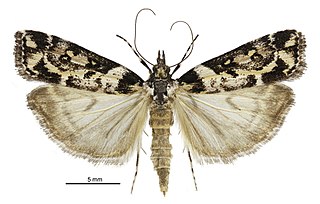
Rhopobota naevana, the holly tortrix moth, holly leaf tier or blackheaded fireworm, is a moth of the family Tortricidae. It is found from Europe to eastern Russia, China, Taiwan, Mongolia, Korea and Japan. It is also present in India, Sri Lanka and North America.
Xyroptila peltastes is a moth of the family Pterophoridae. It is found in Australia.

Phyllonorycter nigrescentella is a moth of the family Gracillariidae. It is known from all of Europe except the Balkan Peninsula.

Eudonia diphtheralis is a species of moth in the family Crambidae. It is endemic to New Zealand.

Epinotia tetraquetrana, the square-barred bell, is a moth of the family Tortricidae. It is found from most of Europe east to the Near East and the eastern part of the Palearctic realm.
Anarsia eriozona is a moth of the family Gelechiidae. It was described by Edward Meyrick in 1921. It is found in Mozambique and Kenya.
Dichomeris cotifera is a moth in the family Gelechiidae. It was described by Edward Meyrick in 1913. It is found in Mpumalanga, South Africa.
Dichomeris ligyra is a species of moth in the family Gelechiidae. It was described by Edward Meyrick in 1913. It is found in Gauteng, South Africa.
Helcystogramma malacogramma is a moth in the family Gelechiidae. It was described by Edward Meyrick in 1909. It is found in Zimbabwe and Gauteng, South Africa.
Ardozyga gorgonias is a species of moth in the family Gelechiidae. It was described by Edward Meyrick in 1904. It is found in Australia, where it has been recorded from Queensland.
Parapsectris tholaea is a moth in the family Gelechiidae. It was described by Edward Meyrick in 1911. It is found in South Africa, Namibia and Zimbabwe.
Idiophantis anisosticta is a moth of the family Gelechiidae. It was described by Edward Meyrick in 1916. It is found in Sri Lanka and Myanmar.
Autosticha vicularis is a moth in the family Autostichidae. It was described by Edward Meyrick in 1911. It is found in Sri Lanka.
Antaeotricha modulata is a species of moth of the family Depressariidae. It is found in Brazil, Guyana and French Guiana.
Carodista paroristis is a moth in the family Lecithoceridae. It was described by Edward Meyrick in 1911. It is found in Sri Lanka.
Aeolanthes dicraea is a moth in the family Depressariidae. It was described by Edward Meyrick in 1908. It is found in India (Assam).
Gonionota oligarcha is a moth in the family Depressariidae. It was described by Edward Meyrick in 1913. It is found in Peru.
Imma nephallactis is a moth in the family Immidae. It was described by Edward Meyrick in 1906. It is found in Venezuela.
Imma thyriditis is a moth in the family Immidae. It was described by Edward Meyrick in 1906. It is found on the Solomon Islands.

Tingena horaea is a species of moth in the family Oecophoridae. It is endemic to New Zealand and have been observed in both the North and South Islands. The adults are on the wing in January.



